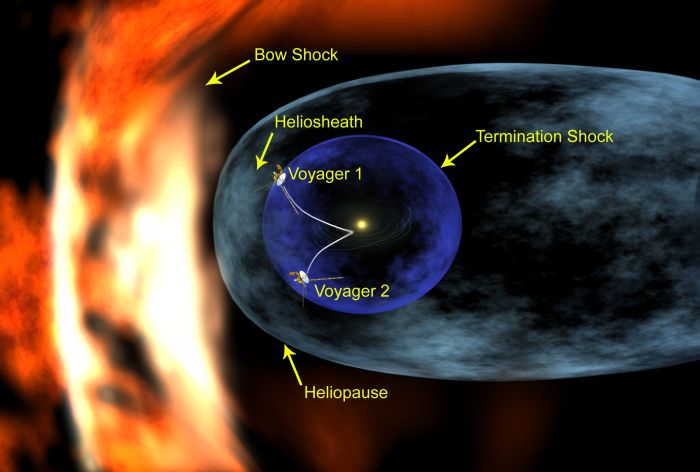
|
Credit: Walt Feimer,
NASA
Explanation:
Launched
in 1977, Voyager 1 is now about 12 light-hours
or 90 astronomical
units (AU) from the
Sun, making this spacecraft humanity's most
distant ambassador to the cosmos.
Well beyond the orbits of the outer planets, Voyager 1
is believed to be
entering
the realm of deep space
near the edge of
the
heliosphere, the region dominated by
the solar wind and magnetic field.
Causing
some debate, new results from instruments still
operating have given indications that the spacecraft
could finally be encountering a fluctuating
boundary known as the solar wind's termination shock.
Illustrated above, the bubble-shaped termination shock is
produced when the
wind from the Sun slows dramatically
and piles up as it runs in to the tenuous interstellar gas.
Still farther out, beyond
the heliopause,
solar wind and interstellar gas begin to mix,
while the heliosphere's motion through interstellar space creates
a bow shock, analogous to
a boat moving through water.
Estimates are that both Voyager 1 and 2 have enough
power and fuel to operate until about the year 2020.
The spacecraft continue to coast toward interstellar space
at over 3 AU per year.
|
January February March April May June July August September October November December |
| ||||||||||||||||||||||||||||||||||||||||||||||||
NASA Web Site Statements, Warnings, and Disclaimers
NASA Official: Jay Norris. Specific rights apply.
A service of: LHEA at NASA / GSFC
& Michigan Tech. U.
Based on Astronomy Picture
Of the Day
Publications with keywords: Voyager project - Heliosphere - solar wind
Publications with words: Voyager project - Heliosphere - solar wind
See also:
